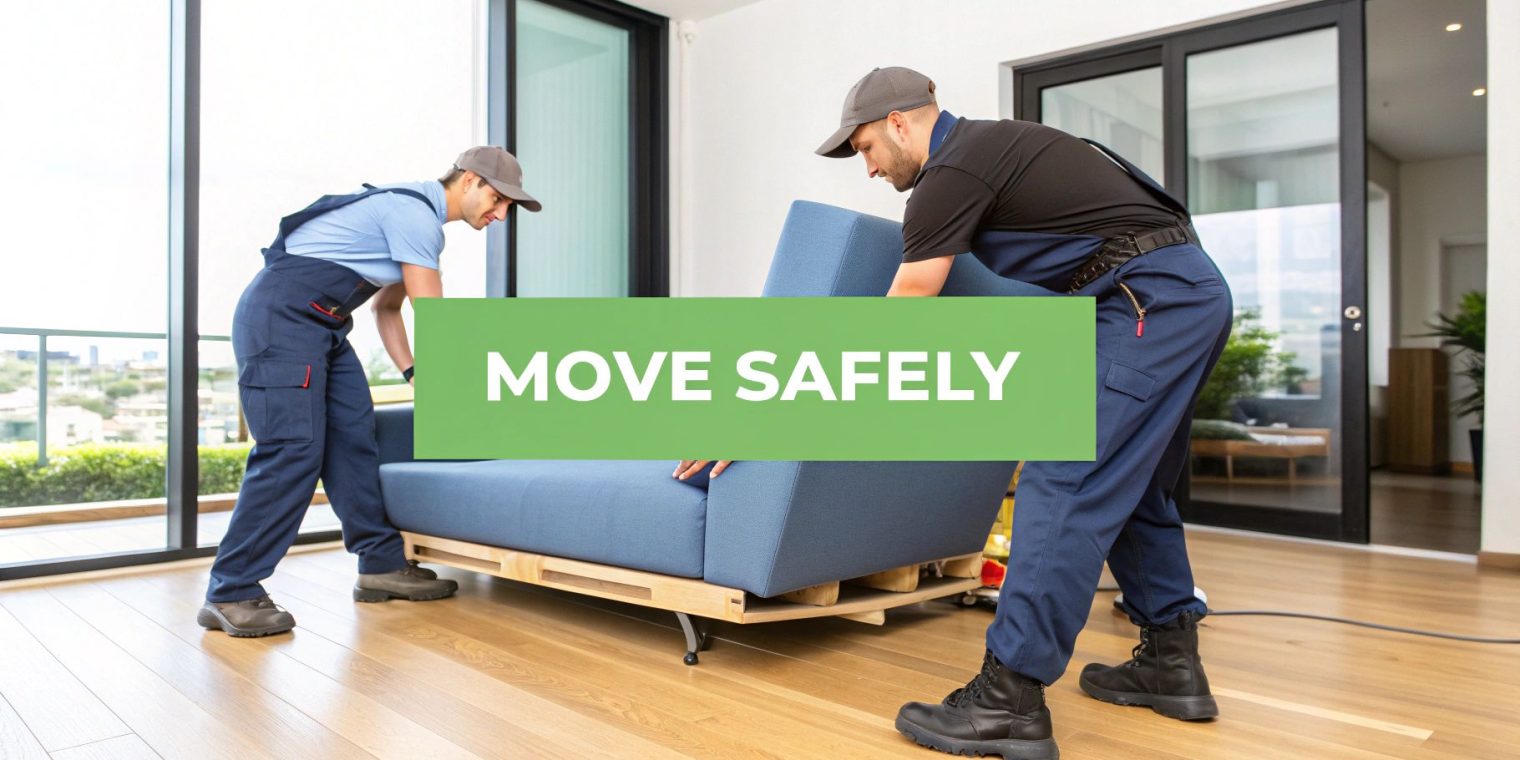When you’re staring down a bulky piece of furniture, it's easy to feel intimidated. But moving heavy items successfully isn't about brute force; it's about having a solid plan. The real trick is to work smarter, not harder. A good strategy focuses on assessing the item and its path, prepping your home and the furniture itself, getting the right tools for the job, and using proper lifting techniques to keep everyone safe.
This approach is all about prioritising safety and preventing damage—to your belongings, your home, and your back.
Your Game Plan for a Successful Move
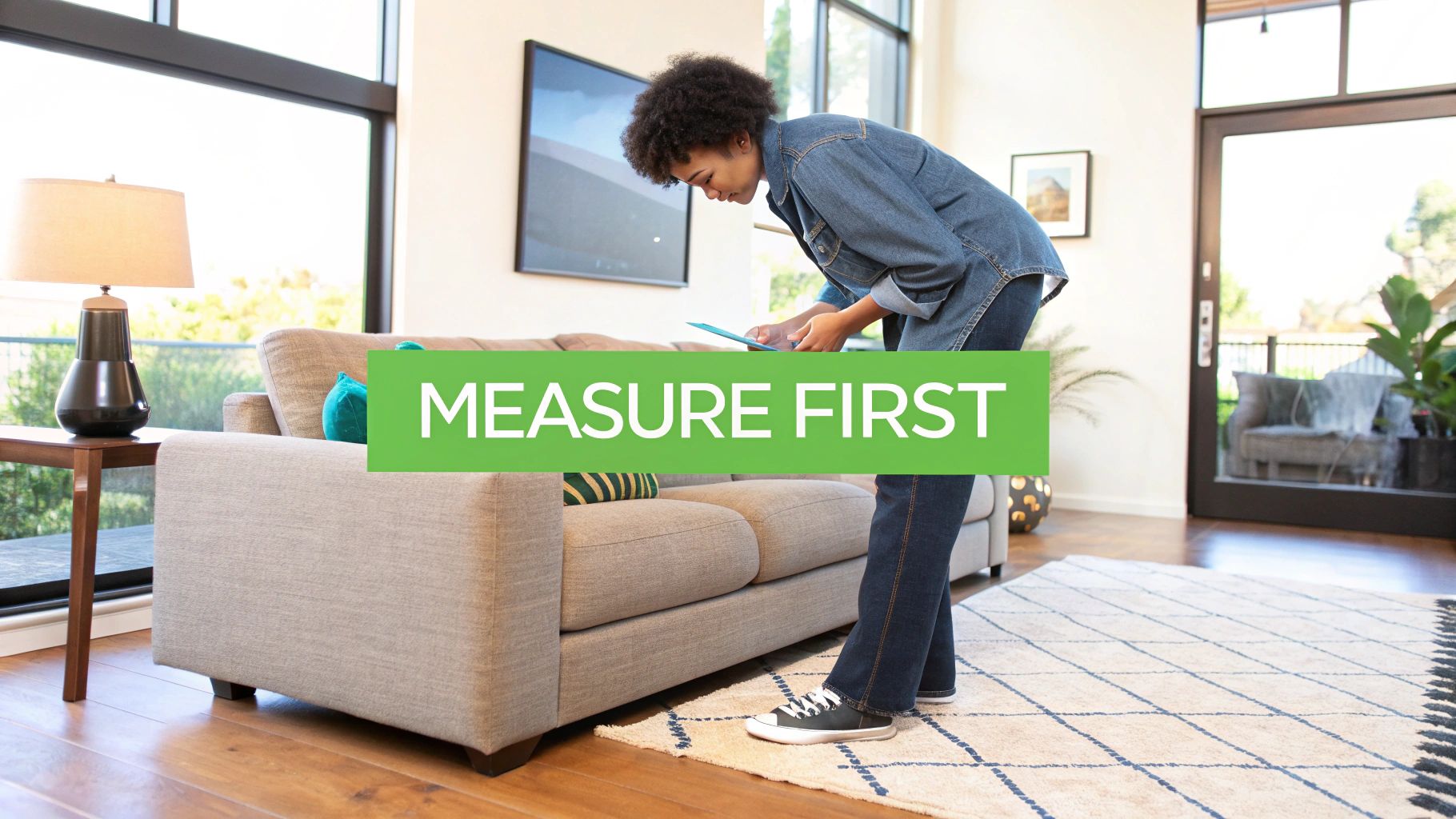
Trying to wrestle a solid oak wardrobe or a cumbersome sofa out the door with sheer muscle is a recipe for disaster. I've seen it countless times: scratched floors, dented walls, and painful injuries. The secret to moving heavy furniture lies in strategic planning, not in being the strongest person in the room.
Think of it as your blueprint for a smooth move. A successful plan begins long before you even touch the furniture. Start by measuring everything—the furniture, of course, but also every doorway, hallway, and tight corner on its exit route. This simple step can save you from that classic, frustrating "stuck in the doorway" moment.
Prioritising Safety and Preparation
Having the right equipment is the foundation of any good move. It's all about leverage, which is far more effective than just trying to lift with pure strength. The right tools make this possible. It's helpful to distinguish between what's absolutely essential and what's just a nice extra to have.
Here’s a quick reference guide to help you figure out what you truly need.
Essential vs. Optional Moving Equipment
| Tool | Category | Primary Use | Recommended For |
|---|---|---|---|
| Furniture Dolly | Essential | Transporting heavy, bulky items over flat surfaces | Wardrobes, fridges, washing machines, large cabinets |
| Moving Blankets | Essential | Protecting furniture from scratches and dents | All wooden furniture, appliances, and delicate surfaces |
| Lifting Straps | Essential | Reducing strain on your back by using leverage | Mattresses, sofas, and awkwardly shaped, heavy items |
| Furniture Sliders | Optional | Moving heavy items across carpet or hard floors | Bookcases, desks, and dressers on the same level |
| Shrink Wrap | Optional | Securing blankets and keeping doors/drawers shut | Securing items on a dolly, protecting upholstery |
| Gloves | Essential | Improving grip and protecting your hands | All lifting and carrying to prevent splinters and slips |
This distinction helps you focus your resources on what will make the biggest difference in keeping your move safe and efficient.
A well-thought-out strategy transforms what could be a chaotic struggle into a controlled, manageable process. Your goal should be to make the furniture feel as light as possible by using physics to your advantage, not by overexerting yourself.
This is especially true for long-distance relocations. Interstate moves, for example, present some serious logistical challenges. In fact, recent data shows that nearly one-third of Australians who moved in the past year undertook such a relocation. The sheer scale of moving heavy items across states has made professional removalists, who come equipped with all the right gear, an increasingly popular choice.
Ultimately, a solid plan gives you the confidence to tackle the job. For a step-by-step guide to getting your entire relocation in order, be sure to check out your ultimate moving checklist for 2025 for more expert tips.
Choosing the Right Tools for the Job
Trying to wrestle a solid oak wardrobe or a massive entertainment unit across the room without the right gear is a rookie mistake we’ve all been tempted to make. It’s a fast track to scratched floors, dented walls, and a trip to the chiropractor. Moving heavy furniture isn't about brute force; it’s about working smarter, not harder, using tools that do the heavy lifting for you.
Think of this equipment as your moving day crew. Each tool has a specific job, turning what feels like an impossible, dangerous task into something you can actually manage.
Tools for Sliding and Gliding
First up, let's talk about the simple stuff that helps you slide and roll furniture. These are your best friends for any heavy move happening on one level, drastically cutting down the muscle you need to use.
Furniture sliders are one of those "why didn't I think of that?" tools. They're just small discs—some with hard plastic on one side and soft felt on the other—that you pop under the corners of a heavy piece.
- On carpet: Use sliders with a slick plastic bottom. They’ll glide over the carpet pile with barely any friction. A 100-kilogram bookcase that was impossible to budge suddenly feels almost weightless, needing just a gentle push.
- On hard floors: Grab the sliders with a soft, felt bottom. These are essential to stop scratches on your precious timber, laminate, or tile floors.
Using them is easy. You just carefully tilt the furniture to one side, slip the sliders under the feet, and then do the same on the other side. That one small action changes everything.
Equipment for Rolling and Lifting
When you're moving more than just a few metres across a room, you need to bring in the wheels. This is where dollies and hand trolleys go from being ‘nice-to-have’ to ‘absolutely essential’.
A four-wheel furniture dolly is your workhorse. It’s that simple, flat platform on castor wheels you see the pros using. It’s perfect for shifting bulky, box-shaped items like dressers, washing machines, or heavy cabinets down long hallways. Once the item is on the dolly, you just need to guide it.
An appliance dolly (you might know it as a hand trolley) is the L-shaped, two-wheeled tool that gives you amazing leverage for taller things like fridges or filing cabinets. The upright design lets you tilt the item back, balancing its weight over the wheels and making it so much easier to control.
A Word of Warning: Always check the weight rating on a dolly. A cheap one from a discount store can easily buckle under the strain of solid timber furniture. It's always better to rent or buy one rated for well above the weight of your heaviest piece.
Then you have lifting straps, often called moving harnesses. For awkwardly shaped items like sofas and mattresses, especially when you’re facing a set of stairs, these are an absolute game-changer.
These straps use basic leverage to shift the weight off your fragile back and onto your shoulders and stronger leg muscles. Research into lifting biomechanics has actually shown these kinds of harnesses can seriously reduce the compressive force on your spine. It means you and a partner can carry heavy things more safely and without feeling completely wrecked afterwards.
Your Personal Safety Gear
The furniture and the house aren't the only things that need protecting on moving day. Your own safety is the top priority, and a few key pieces of gear can prevent the most common—and painful—injuries.
- High-Grip Gloves: These are non-negotiable. A good pair of gloves gives you a much better hold, stopping heavy items from slipping. They also save your hands from splinters, sharp edges, and pinched fingers.
- Steel-Toed Boots: It might feel like overkill, but trust me, dropping a chest of drawers on your foot can cause serious, long-term damage. At a minimum, wear sturdy, closed-toe shoes with ankle support. Steel-toed boots are the gold standard for protection.
- Comfortable Clothes: Wear something that lets you move freely but isn't so baggy it could get snagged on a door handle or a sharp corner.
You can usually rent dollies, straps, and moving blankets from local hire shops or truck rental places. For things like sliders and gloves, a quick trip to a hardware store like Bunnings is all it takes. Spending a little on the right gear pays for itself many times over in safety and efficiency.
How to Prepare Your Furniture and Home
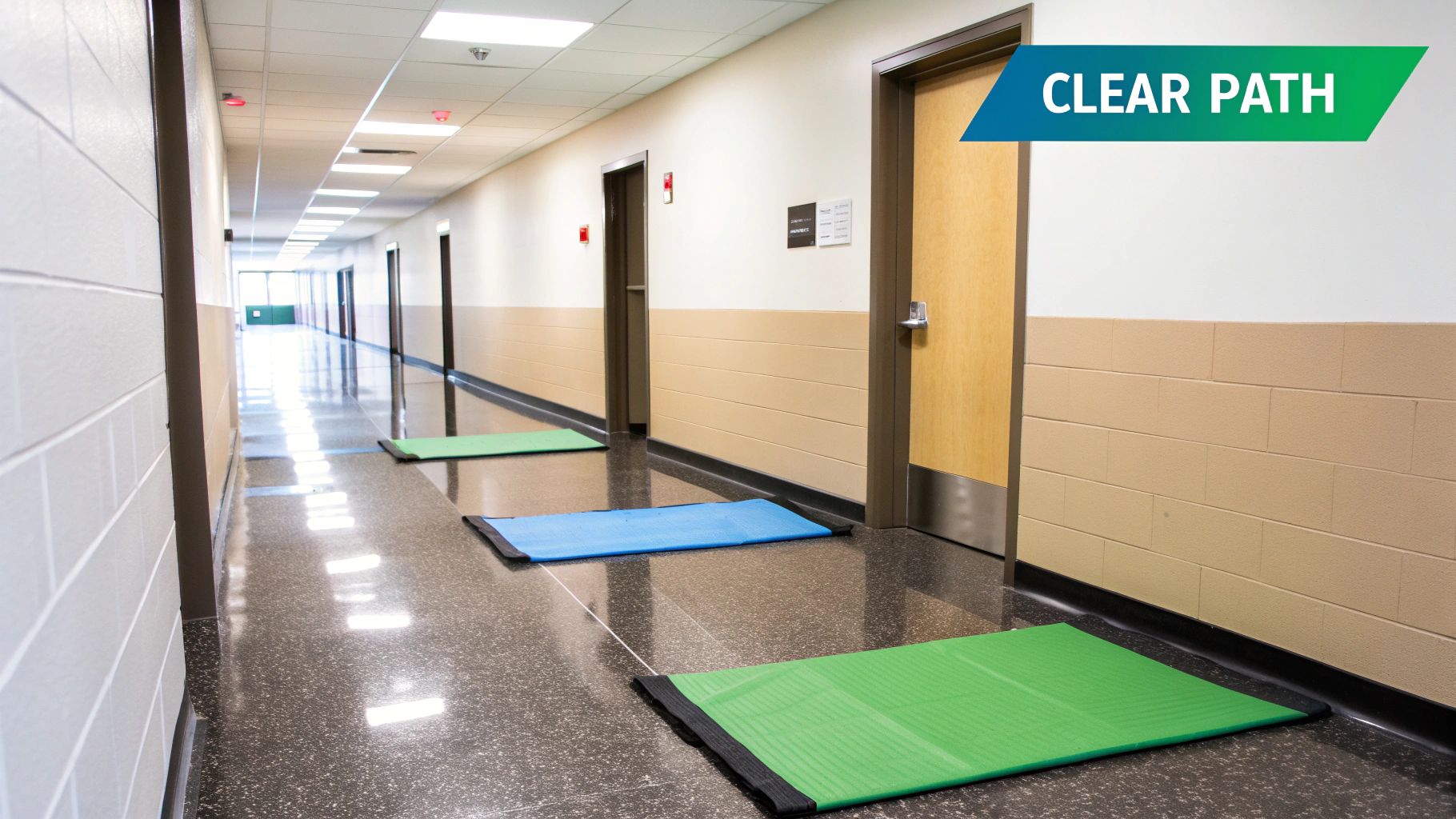
Ask any experienced mover, and they'll tell you the secret to a successful move is 90% preparation. The heavy lifting is just the final, sweaty part of the process. Before you even think about shifting that big wardrobe, a bit of smart prep work can save you a world of pain—and the cost of repairing dings in your furniture and your home. This is what separates a smooth, stress-free day from a damage-filled disaster.
It all starts with making your furniture as easy and safe to handle as possible. Lighter and less awkward always means safer.
Dismantle What You Can
Look at each piece of heavy furniture not as one solid block, but as a collection of parts. Your mission is to break it down into its simplest, most manageable components.
- Empty all drawers: A hefty chest of drawers or a big desk can feel dramatically lighter once you pull the drawers out. You can move them separately, making the main frame much less of a beast.
- Take the legs off tables: Most dining tables, coffee tables, and even side tables have legs that can be unbolted. Doing this gives you a flat, easy-to-carry tabletop, and the legs can be bundled up neatly.
- Break down bed frames: This one isn't optional—it's a must. A fully assembled bed frame is just about impossible to get through a doorway. Bag up all the screws and hardware, label the bag clearly, and tape it securely to the largest piece, like the headboard.
Every kilogram you can shed from the main piece makes the job exponentially easier and reduces the risk of injury or damage.
Think about that solid oak dresser in the bedroom. As one piece, it's a monster. But take out its six drawers, and suddenly it's a frame you can actually get your arms around. That simple step can be the difference between a strained back and a successful move.
Protect Your Furniture Like a Pro
Once your furniture is dismantled and as light as it can be, it's time to shield its surfaces. Scratches, chips, and dents are the most common battle scars from a poorly prepped move.
This is where good wrapping comes in. Don’t skimp here—invest in proper moving blankets. They’re thick, padded, and designed specifically for this. Drape them over your furniture, ensuring every single corner and edge is covered.
Then, to keep those blankets snug, use shrink wrap. Wind it around the blanketed item several times until it’s secure. This works far better than packing tape, which can leave a sticky mess or, even worse, peel the finish right off your wood. If you use tape at all, only use it to stick the end of the shrink wrap to itself—never directly onto the furniture.
Prepare Your Home for Safe Passage
Protecting your furniture is only half the job. You also need to safeguard your house. Walls, door frames, and floors are all in the firing line when you’re trying to navigate a bulky sofa around a tight corner.
First, create a clear, wide runway from where the furniture is to the exit. Move every little thing out of the way—rugs, pot plants, lamps, side tables. Anything that could trip someone up has to go.
With the path cleared, it's time to armour your home.
- Floors: For timber or tiled floors, lay down flattened cardboard boxes, old blankets, or floor runners. It’s less critical for carpet, but it can stop dirt and scuffs.
- Doorways: Door frames are magnets for dings and scrapes. A simple trick is to tape cardboard or foam padding to the corners to create a soft buffer.
- Sharp Wall Corners: Any tight, exposed corner on your moving route is a risk. A bit of painter's tape and a folded-up towel or some cardboard can prevent a nasty gouge.
This kind of thorough preparation is becoming increasingly vital. In Australia, the home furniture market hit USD 17.0 billion and is projected to climb to USD 34.3 billion by 2030. This growth is driven by new homes and a trend towards larger, statement furniture pieces. As our furniture gets bigger and better, the need for smart, safe moving techniques is more important than ever. You can explore more about these market trends and see how they’re shaping the way we move.
Lifting and Carrying Techniques That Actually Work
Alright, with your home and furniture prepped, we’ve arrived at the main event. This is where a bit of physics becomes your best friend, easily outperforming brute strength every single time. Knowing how to move heavy furniture safely is a real skill—one that the pros rely on to avoid injuries and prevent thousands of dollars in damage. It’s about so much more than the old advice to just ‘lift with your legs’.
Think of it this way: proper technique is a mix of good posture, a tight core, smart positioning, and clear communication. Forget about trying to heroically deadlift a solid oak wardrobe. Instead, your goal should be to make every single movement deliberate and controlled.
The Foundation of a Safe Lift
Before you even think about lifting that box, get your body into the right position. Stand with your feet about shoulder-width apart to create a solid, stable base. Now, get as close to the object as you possibly can. The further it is from your centre of gravity, the heavier it feels, putting a ridiculous amount of strain on your lower back.
The sequence of your movement is what really matters. You want to bend at your hips and knees, not at your waist. Picture a squat or a deadlift at the gym—that’s the movement you're after. Keep your back straight. This doesn't mean perfectly vertical, but it must be straight and rigid. To lock it in place, engage your core by tightening your stomach muscles as if you're about to take a punch. This simple action is one of the most effective ways to support your spine and prevent injury.
When you’re ready to lift, drive the power up through your legs and glutes to stand. Never, ever use your back to yank the weight off the floor. Honestly, that’s the single biggest mistake people make.
Essential Partner Communication
If you're moving with a partner, talking to each other isn't optional—it's non-negotiable. You’re a team, and you have to move like one cohesive unit. Before you even touch the item, agree on the game plan. Figure out who's leading, the exact path you’ll take, and where you plan to set it down.
Use simple, clear commands. No need for complex language. Try things like:
- "Ready to lift on three. One, two, three, lift."
- "Moving forward. Watch the corner on your left."
- "Need to put this down. Ready? Three, two, one, down."
Checking in regularly is just as important. A quick "How's your grip?" or "You still comfortable?" can stop an accident before it happens. Don't just assume your partner is fine; always ask. This coordination prevents the jerky, out-of-sync movements that so often lead to dropped furniture and pulled muscles.
Pro Tip: Never twist your body while carrying a heavy load. Your spine is under a lot of compression, and twisting is a fast track to a serious back injury. To change direction, move your feet. Take small, shuffling steps to pivot instead of twisting at your waist.
Advanced Techniques for Awkward Items
Standard lifting form is great for a perfectly packed box, but let's be real—furniture is rarely that cooperative. Different shapes demand different strategies. Learning a few professional methods is what separates a frustrating struggle from a smooth move.
The High-Low Method for Sofas and Dressers
This is the classic, go-to technique for getting long, bulky items like sofas, dressers, or long entertainment units through tight doorways. You'll need two people for this.
- As you get to the doorway, one person holds their end up high (around chest or shoulder height), while the other carries their end low (at waist or knee height).
- This clever tilt puts the furniture on a diagonal, which makes it "shorter" and allows it to hook neatly around the corner.
- The person on the low end guides the bottom of the furniture through the doorway first.
- Once the front half is clear, you can level it out and keep moving.
Think about trying to get a long pencil through a tiny hole—you wouldn't just shove it straight through. You'd angle it. The high-low method applies that same simple logic to your three-seater sofa.
The 'L-Lift' for Tall Furniture
For anything tall and top-heavy, like a bookcase or a wardrobe, the 'L-Lift' (sometimes called the 'tilt and carry' method) is far safer than trying to haul it around upright.
Have two people stand on either side of the item and carefully tilt it backwards to about a 45-degree angle. One person supports the top of the piece while the other has the bottom. In this position, the centre of gravity is much lower and more stable, making it incredibly easy to carry without it threatening to topple over.
This technique is a lifesaver when going up or down a few stairs because it keeps the weight evenly balanced between both people. It's a fundamental skill for moving almost any tall piece of furniture you own.
Let’s be honest—stairs and tight corners are where most DIY moves go wrong. They’re the final boss of furniture moving, the spots where knuckles get scraped, walls get dented, and tempers flare. But these obstacles aren't impossible. With the right strategy, you can get through them safely and without a scratch.
It all boils down to control, clear communication, and working with gravity, not against it.
Mastering the Staircase
Moving something big and heavy, like a washing machine or a tallboy, down a flight of stairs is genuinely one of the most dangerous parts of any move. The most critical rule is simple: the strongest person always goes at the bottom. Their job isn't just to hold the weight; they're the brakes, controlling the entire descent. The person at the top is there purely to guide the item.
When you're going up the stairs, the roles flip. The strongest person is still at the bottom, but now they're providing the lifting and pushing power, while the person at the top guides it into position.
This is where lifting straps really prove their worth. They let both people stand more upright, which takes a huge amount of strain off your back and improves your balance on the slope. For those who move often or are dealing with extremely heavy items, a proper stair-climbing dolly is a game-changer. Its tri-wheel design and ratchet strap let you roll items up or down each step with far more control.
The following infographic drives home the core safety principles that you should be applying to every part of your move, but they are absolutely essential during these tricky manoeuvres.
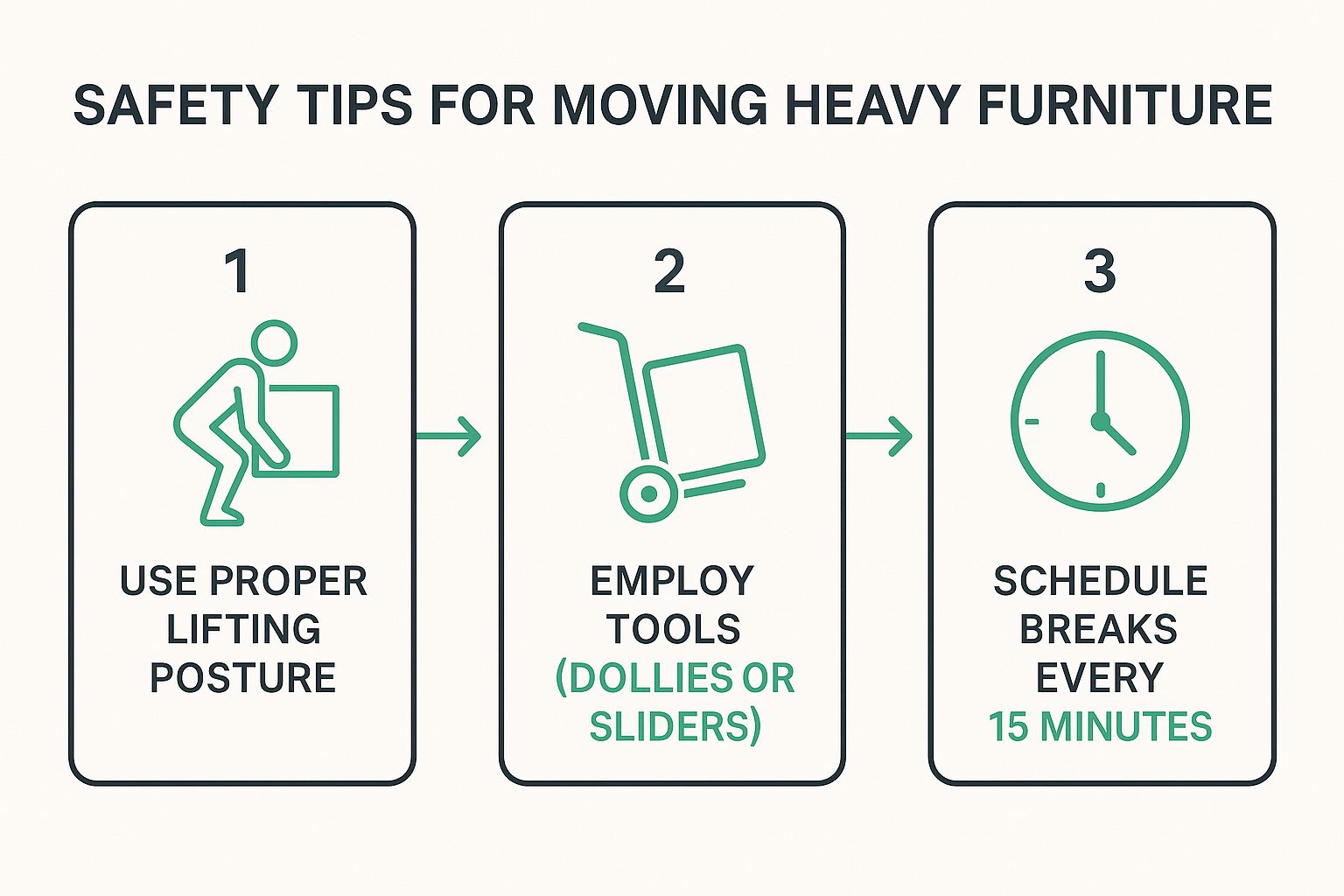
As you can see, it's the combination of good posture, the right equipment, and taking breaks that creates a system for a much safer and more effective move.
Handling Awkward Turns and Obstacles
Those tight, 90-degree hallway turns require a completely different mindset. It's less about raw strength and much more about spatial awareness—like a real-life game of Tetris.
Before you even reach the corner, stop. Put the item down and just visualise the path it needs to take. For long items like a dresser or a tall fridge, the "hook" or "pivot" method is your best friend.
- Approach the corner: Carry the item upright if you can. For something long like a sofa, use the high-low method.
- Hook it around: Instead of trying to turn the whole thing flat, guide one end through the turn first, like you’re hooking it around the corner.
- Pivot and slide: Once the front end is clear, you can pivot the rest of the item through the opening. It's all about the angle.
Sometimes the obstacles are outside. If you need to move a heavy piece across a soft lawn, for instance, don't let the dolly sink into the mud. Lay down a few sheets of plywood to create a solid, temporary path.
A classic mistake is trying to rush through tight spots. Patience is your most important tool here. It’s far better to set the item down, rethink your angles, and try again than to force it and end up with a damaged wall or a broken piece of furniture.
Knowing the specific quirks of different heavy items helps you apply the right technique from the very beginning.
Strategy for Moving Common Heavy Items
Every piece of furniture presents its own puzzle. A tall fridge moves very differently from a floppy mattress. This table breaks down some common challenges and the best way to tackle them.
| Furniture Item | Key Challenge | Recommended Technique | Essential Tool |
|---|---|---|---|
| Tall Refrigerator | Top-heavy and awkward on stairs | 'L-Lift' (tilt and carry) on flat ground; use an appliance dolly for stairs | Appliance Dolly |
| Long Sofa | Won't fit through standard doorways | 'High-Low' method to angle it through the frame | Lifting Straps |
| Solid Timber Dresser | Extreme weight and sharp corners | Remove all drawers first; use the pivot method for tight corners | Four-Wheel Dolly |
| King-Size Mattress | Floppy and hard to grip | Fold it in half (the 'taco' method) and secure with ratchet straps | Lifting Straps |
By matching the right tool and technique to the item, you’re setting yourself up for a much smoother—and safer—move.
Knowing When to Hire Professional Movers
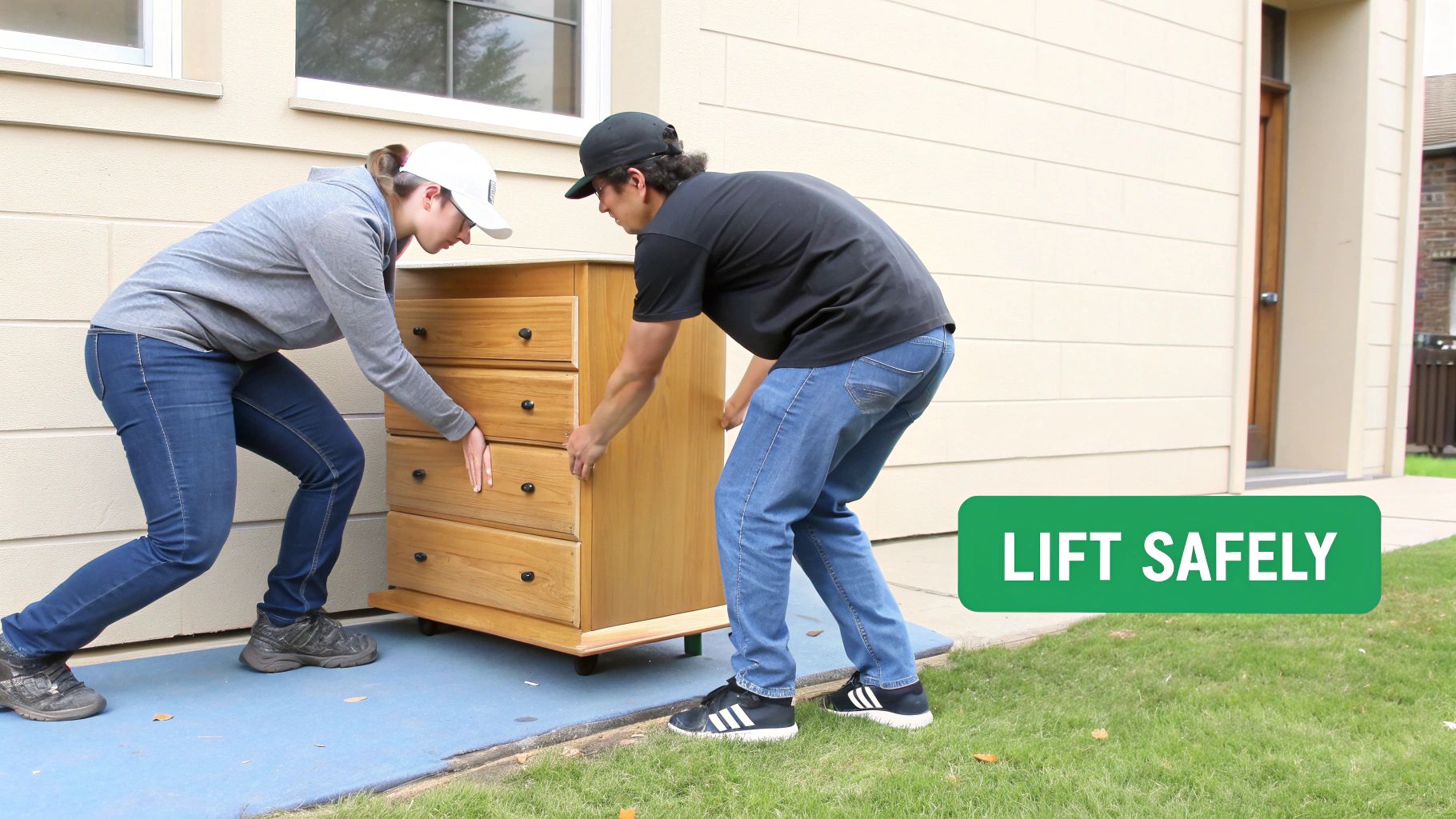
Sometimes, the smartest move is knowing when to let someone else do the heavy lifting. While there’s a certain satisfaction in tackling a move yourself, there are definitely times when the risks just aren't worth it. We're talking risks to your body, your prized possessions, and even your home.
This isn't about giving up; it's about being strategic. A crucial part of knowing how to move heavy furniture is being honest about your own limits. The decision to call in the professionals often comes down to a simple cost-benefit analysis. Think about it: what's more expensive? A team of movers, or an emergency room visit for a slipped disc and a bill to repair that massive scratch in your timber floors?
Key Factors for Calling in the Pros
Consider the actual items you need to shift. A flat-pack bookcase is one thing, but what about those truly difficult, valuable, or just plain awkward pieces?
- Valuable or Fragile Items: If you own a grand piano, a fragile antique armoire, or a heavy marble-topped table, the potential for disaster is just too high for an amateur. Learning how to transport a piano without damage is a specialised skill, and seeing the process often makes it clear why pros are a must.
- Move Complexity: Are you staring down multiple flights of narrow stairs? Or trying to figure out how to pivot a sofa around a tight corner? Professionals come equipped with the right gear and, more importantly, the experience to handle these logistical nightmares without breaking a sweat.
- Personal Risk: Be brutally honest with yourself about your physical fitness. If you have a dodgy back or just don't have the brute strength required, hiring help is a sensible investment in your own well-being.
Vetting a Reputable Moving Company
Picking the right removalist is everything. The Australian removalist industry is significant—handling an estimated $1.8 billion in revenue in 2023—and its reputation is built on trust, especially for tricky moves. When you're looking for local experts, like a team of dedicated https://emmanueltransport.net.au/joondalup-removalists/, focus on companies with clear pricing and a solid track record of positive customer reviews.
Before you commit to anyone, always ask about their insurance. A direct question like, "What's your policy if my furniture or property gets accidentally damaged?" is essential. A professional mover will have a confident and straightforward answer.
Ultimately, hiring a professional team isn't just about paying for muscle. It's about buying peace of mind, knowing your move will be handled safely and efficiently from start to finish.
Common Moving Questions Answered
Even the most organised move can throw you a curveball. There are always those specific situations that leave you standing there, scratching your head. Let's tackle some of the most common questions we hear, giving you the expert clarity you need for those final, tricky details.
What Is the Best Way to Move Heavy Furniture by Myself?
Look, moving heavy furniture solo is never the ideal scenario, but sometimes you don't have a choice. If you find yourself in this situation, physics is your best friend. Your secret weapon? Leverage.
For shifting something across a flat surface, furniture sliders are absolute lifesavers. They dramatically reduce friction. To get them in place, just carefully tilt the item on one side, slip the sliders under the feet, and then do the same for the other side.
If you need to cover any real distance, a furniture dolly is non-negotiable. Your mantra should be to push and pivot, never to lift and carry the entire dead weight. Before you even start, make sure your path is completely clear and protected. But seriously, for safety's sake, always try to rope in at least one helper if you can.
How Can I Get a Heavy Couch Through a Small Door?
Ah, the classic moving day puzzle. First things first: grab a tape measure. You need to know the narrowest dimension of your couch (which is usually its depth) and the exact width of your doorway. More often than not, the answer is to stand the couch on its end and "hook" it through the door.
This technique involves guiding the back and one arm through the doorway first, then carefully swivelling the rest of the couch around the door frame. You can also buy yourself a few precious centimetres of clearance by taking the door right off its hinges. And if the couch legs come off, take them off. It’s all about patient, careful manoeuvring—brute force will only damage your couch or your walls.
Remember, every move presents unique challenges, from tight corners to unexpected obstacles. For a broader look, you can find more expert answers to common moving questions to help you prepare for anything.
How Do I Protect My Wooden Floors?
Whatever you do, don't slide or drag furniture directly across your polished timber floors. That's a surefire way to cause damage you'll regret. The smartest move is to create a protective runway. You can lay down flattened cardboard boxes, old blankets, or even buy specialised floor runners from a hardware store.
If you're using furniture sliders, double-check that they're the soft, felt-bottomed kind made specifically for hardwood. And if you're wheeling out a dolly, inspect its wheels first. Make sure they're clean and free of any tiny rocks or grit that could carve deep, ugly scratches into your floorboards.
Ready to make your move completely stress-free? Let the professionals at Emmanuel Transport handle the heavy lifting. Get your free, no-obligation quote today!

